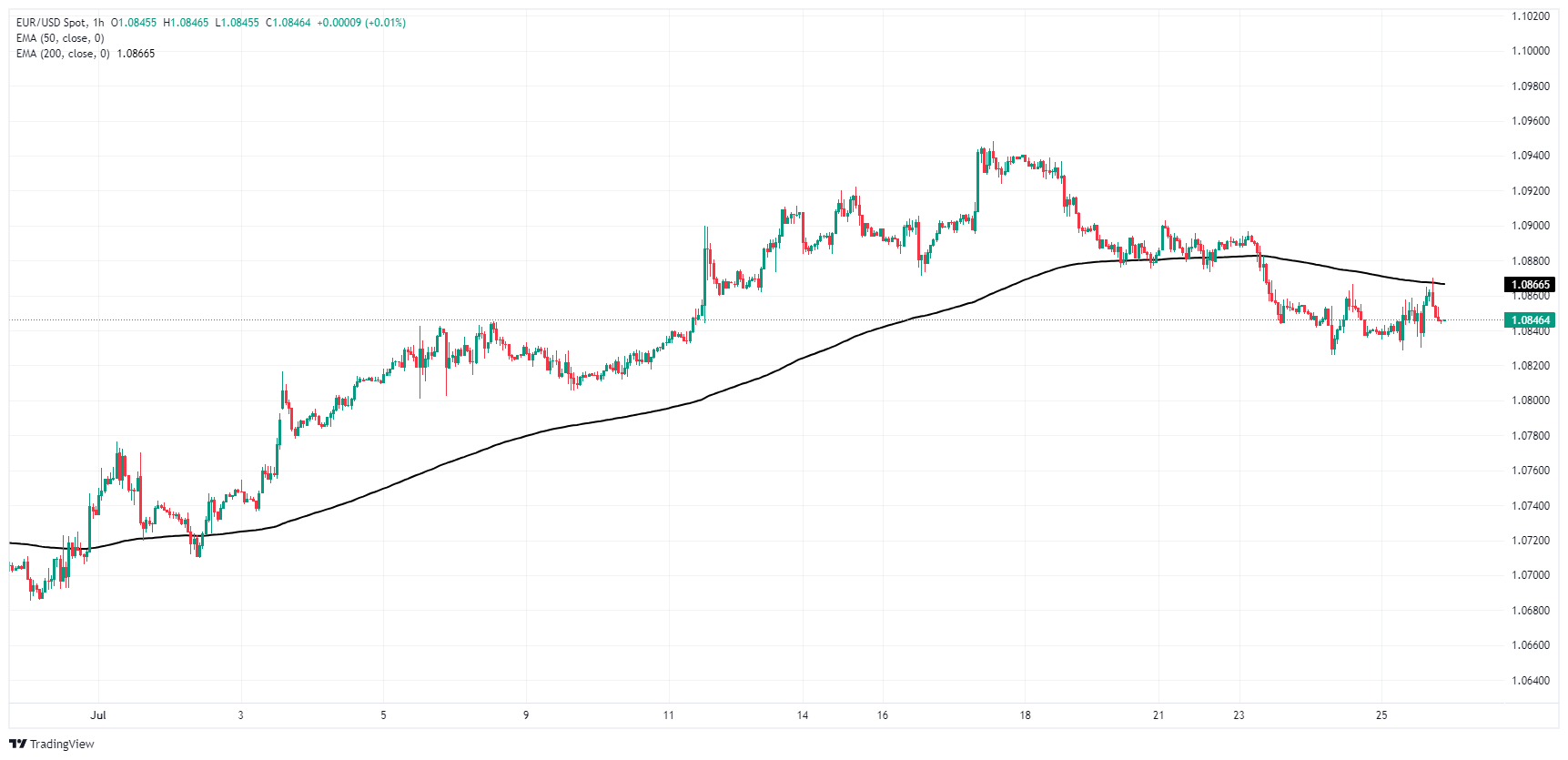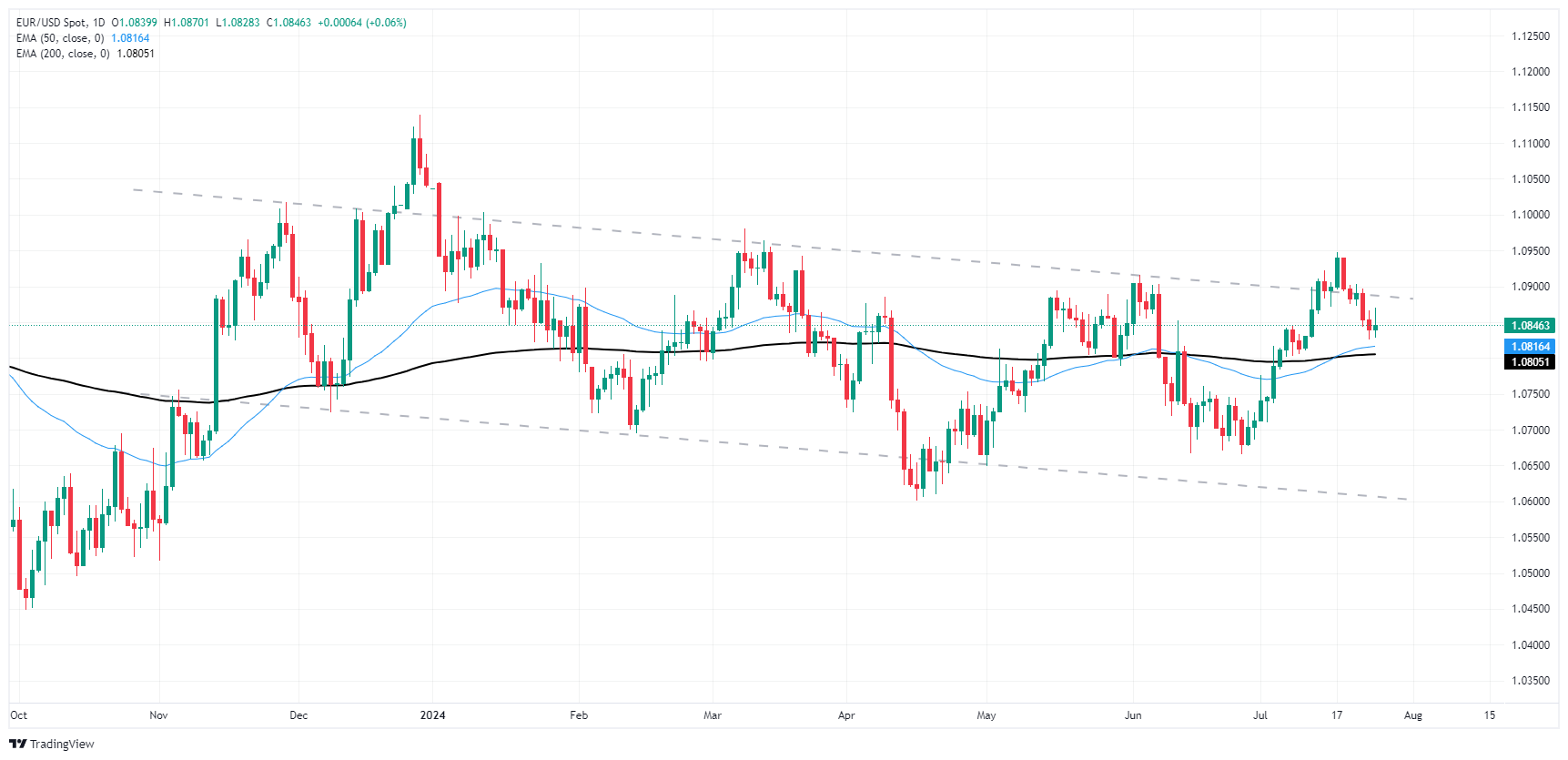- Analytics
- News and Tools
- Market News
- EUR/USD holds steady ahead of key US inflation print
EUR/USD holds steady ahead of key US inflation print
- EUR/USD continued to cycle 1.0850 on Thursday.
- Markets are bracing for one last blast of US inflation data on Friday.
- Euro traders hold steady ahead of next week’s GDP update.
EUR/USD churned in familiar territory on Thursday as markets grappled with a lopsided US data print. Broad-market expectations for a September rate cut from the Federal Reserve (Fed) are still pinned to the ceiling, but there’s nowhere to go but down as US data continues to catch investors off-guard. Euro traders will have to wait for next week’s pan-EU Gross Domestic Product (GDP) update, and next Wednesday’s latest Fed rate call looms large over the horizon.
Forex Today: Can US PCE confirm a rate cut in September?
Friday is going to be a decidedly USD-centric affair with US Personal Consumption Expenditure Price Index (PCE) inflation in the barrel. Markets are hoping for a continued cooling in the Fed’s favored inflation metric, with median forecasts calling for core PCE inflation to tick down to 2.5% YoY in June compared to the previous print of 2.6%.
Euro traders will have to swim in circles while waiting for EU data that will move the needle. Pan-EU GDP figures for the second quarter are slated for next Tuesday. QoQ Q2 EU GDP is forecast to shift lower to 0.2% from the previous 0.3%.
The Fed is still broadly expected to keep interest rates unchanged in July at 5.5%, with rate markets broadly focusing on a September rate trim. At current cut, the CME’s FedWatch Tool shows rate traders are pricing in 100% odds of at least a quarter-point decline in the Fed’s benchmark rate on September 18.
US Gross Domestic Product (GDP) lurched higher in the second quarter, bringing annualized Q2 growth to 2.8%, well above the forecast 2.0% and piling onto the first quarter’s 1.4%. Markets initially recoiled from the firm upswing in growth figures, but a sharp contraction in US Durable Goods Orders helped keep hopes pinned for softening data to help push the Federal Reserve (Fed) toward a September rate cut.
Economic Indicator
Core Personal Consumption Expenditures - Price Index (YoY)
The Core Personal Consumption Expenditures (PCE), released by the US Bureau of Economic Analysis on a monthly basis, measures the changes in the prices of goods and services purchased by consumers in the United States (US). The PCE Price Index is also the Federal Reserve’s (Fed) preferred gauge of inflation. The YoY reading compares the prices of goods in the reference month to the same month a year earlier. The core reading excludes the so-called more volatile food and energy components to give a more accurate measurement of price pressures." Generally, a high reading is bullish for the US Dollar (USD), while a low reading is bearish.
Read more.Next release: Fri Jul 26, 2024 12:30
Frequency: Monthly
Consensus: 2.5%
Previous: 2.6%
Source: US Bureau of Economic Analysis
After publishing the GDP report, the US Bureau of Economic Analysis releases the Personal Consumption Expenditures (PCE) Price Index data alongside the monthly changes in Personal Spending and Personal Income. FOMC policymakers use the annual Core PCE Price Index, which excludes volatile food and energy prices, as their primary gauge of inflation. A stronger-than-expected reading could help the USD outperform its rivals as it would hint at a possible hawkish shift in the Fed’s forward guidance and vice versa.
EUR/USD technical outlook
Fiber traders took a break from shorting on Thursday, giving the Euro a chance to catch its breath as the pair holds on the low side of a pullback from recent highs near 1.0950. The pair has fallen back into a rough descending channel, but daily candlesticks have thus far refused to pare back to the 200-day Exponential Moving Average (EMA) at 1.0795.
Buyers will be looking for a chance to reverse course and drag price action back into the high side and break 2024’s slow death spiral, but bearish momentum remains high and EUR/USD could see an extended backslide to the year’s lows below the 1.0700 handle.
EUR/USD hourly chart
EUR/USD daily chart
Euro FAQs
The Euro is the currency for the 20 European Union countries that belong to the Eurozone. It is the second most heavily traded currency in the world behind the US Dollar. In 2022, it accounted for 31% of all foreign exchange transactions, with an average daily turnover of over $2.2 trillion a day. EUR/USD is the most heavily traded currency pair in the world, accounting for an estimated 30% off all transactions, followed by EUR/JPY (4%), EUR/GBP (3%) and EUR/AUD (2%).
The European Central Bank (ECB) in Frankfurt, Germany, is the reserve bank for the Eurozone. The ECB sets interest rates and manages monetary policy. The ECB’s primary mandate is to maintain price stability, which means either controlling inflation or stimulating growth. Its primary tool is the raising or lowering of interest rates. Relatively high interest rates – or the expectation of higher rates – will usually benefit the Euro and vice versa. The ECB Governing Council makes monetary policy decisions at meetings held eight times a year. Decisions are made by heads of the Eurozone national banks and six permanent members, including the President of the ECB, Christine Lagarde.
Eurozone inflation data, measured by the Harmonized Index of Consumer Prices (HICP), is an important econometric for the Euro. If inflation rises more than expected, especially if above the ECB’s 2% target, it obliges the ECB to raise interest rates to bring it back under control. Relatively high interest rates compared to its counterparts will usually benefit the Euro, as it makes the region more attractive as a place for global investors to park their money.
Data releases gauge the health of the economy and can impact on the Euro. Indicators such as GDP, Manufacturing and Services PMIs, employment, and consumer sentiment surveys can all influence the direction of the single currency. A strong economy is good for the Euro. Not only does it attract more foreign investment but it may encourage the ECB to put up interest rates, which will directly strengthen the Euro. Otherwise, if economic data is weak, the Euro is likely to fall. Economic data for the four largest economies in the euro area (Germany, France, Italy and Spain) are especially significant, as they account for 75% of the Eurozone’s economy.
Another significant data release for the Euro is the Trade Balance. This indicator measures the difference between what a country earns from its exports and what it spends on imports over a given period. If a country produces highly sought after exports then its currency will gain in value purely from the extra demand created from foreign buyers seeking to purchase these goods. Therefore, a positive net Trade Balance strengthens a currency and vice versa for a negative balance.
© 2000-2025. All rights reserved.
This site is managed by Teletrade D.J. LLC 2351 LLC 2022 (Euro House, Richmond Hill Road, Kingstown, VC0100, St. Vincent and the Grenadines).
The information on this website is for informational purposes only and does not constitute any investment advice.
The company does not serve or provide services to customers who are residents of the US, Canada, Iran, The Democratic People's Republic of Korea, Yemen and FATF blacklisted countries.
Making transactions on financial markets with marginal financial instruments opens up wide possibilities and allows investors who are willing to take risks to earn high profits, carrying a potentially high risk of losses at the same time. Therefore you should responsibly approach the issue of choosing the appropriate investment strategy, taking the available resources into account, before starting trading.
Use of the information: full or partial use of materials from this website must always be referenced to TeleTrade as the source of information. Use of the materials on the Internet must be accompanied by a hyperlink to teletrade.org. Automatic import of materials and information from this website is prohibited.
Please contact our PR department if you have any questions or need assistance at pr@teletrade.global.















